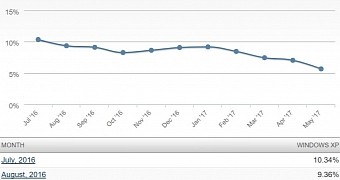Windows XP was one of the widely-used versions of Microsoft's desktop operating system that were hit by the WannaCry ransomware, and as compared to newer releases, it needed an emergency patch from the parent company to keep systems secure and block infections.
This is because Windows XP no longer receives support since April 2014, and with so many PCs still running it, security experts and Microsoft alike reminded that upgrading to supported Windows is the only way to go to remain secure.
And it turns out that many Windows XP users got the message, as new statistics show that XP's market share collapsed last month, dropping from 7.04 percent to 5.66 percent.
Small decline in the last 10 months
Leaving aside the fact that more than 7 percent of computers were still running Windows XP despite the fact that it hasn't received a single patch in the last 3 years, the 1.38 percent decline is the biggest it experienced in the last 12 months and it needed a fiasco like WannaCry to finally convince users to accelerate upgrade efforts.
Windows XP was running on no less than 10.34 percent of computers in July 2016, so the operating system barely lost 3 percent market share points in approximately 10 months, despite no longer getting patches and security updates. Furthermore, it even increased its share in January when it managed to grow from 9.07 percent the month before to 9.17 percent.
Even though Microsoft rolled out an emergency update to protect Windows XP systems against WannaCry ransomware, this still doesn't mean that this is a secure operating system. All the other vulnerabilities that were discovered before WannaCry are still there and could open systems to additional exploits, and this means that upgrading to supported Windows is indeed the only option.
At this point, the Windows versions that are still getting updates are Windows 7 (whose support ends in January 2020), Windows 8.1 and Windows 10.

 14 DAY TRIAL //
14 DAY TRIAL //